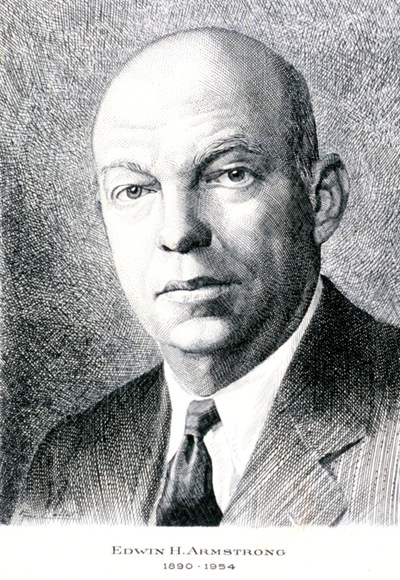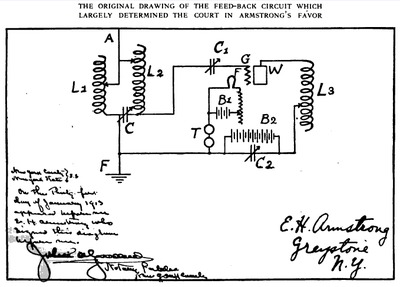The FM innovator
Thursday, 25 July, 2013
Considered by many to be the most prolific inventor in radio history, Edwin Armstrong, the pioneer of FM, is barely known today.
As radio inventors go, Edwin Howard Armstrong was at the head of the pack. Without him we would not have the superheterodyne, the super regenerative circuit and FM. He has been described as the “most prolific and influential inventor in radio history”.
Armstrong was born in New York in 1890 and studied at Columbia University where he later became a professor. He went on to hold 42 patents and awards that included the first Institute of Radio Engineers (now the IEEE) Medal of Honour. He is also on the roster of the International Telecommunications Union’s great inventors.
As a child, Armstrong suffered from Saint Vitus Dance, a disease that left him with a lifelong tic. Because of this he was removed from school for two years, which, although leaving him withdrawn, sharpened an interest in electrical and mechanical devices, especially trains. While at home, and loving the challenge of heights, he built a radio antenna tower and used a boson’s chair to heave himself up and down the structure.
When America joined World War I in 1917, Armstrong joined the army as a captain and went to Paris to help set up a military communications network before returning to the US in 1919.
As a signals officer, he designed the superheterodyne circuit. This had a dramatic effect on contemporary radio, making receivers more sensitive and selective. One of the greatest benefits, however, was a reduction in the number of tuning controls, making operation much simpler.

Later, working from the attic in his parents’ home, he developed the regenerative circuit, the superheterodyne and the super regenerative circuit. Amplification using positive feedback, the basis of regeneration, is still in use. Early on, Armstrong discovered that Lee de Forest’s Audion was most unstable when feedback was increased, but it did mean that the device could be used not only to detect and amplify signals but also to transmit them.
Equal in importance to the superhet and regenerative developments was wideband frequency modulation, largely conceived by Armstrong in the basement laboratory of Columbia University’s Philosophy Hall. This totally new concept of radio transmission relied on varying the frequency of the modulated information rather than its amplitude. The greatest benefits of this new technology were a wider range of audio frequencies and the almost silent background, which was quite clear of extraneous noise such as static.
John Renshaw Carson of AT&T, inventor of single sideband modulation, in 1922 claimed that FM did not seem to have any advantages over AM as there was still background noise. Armstrong refuted this in a paper published in 1936. It is generally accepted today that narrowband does not have the same level of reduced noise as wideband FM, and the signal has to exceed a certain strength before worthwhile noise reduction is achieved, which means that Carson was not entirely wrong.
In 1934 David Sarnoff, the president of RCA, invited Armstrong to work with his company. But although Sarnoff was impressed with FM technology, he also saw it as a threat to his own AM empire and soon refused to support it further.
This did not stop Armstrong conducting field tests of FM from a laboratory built by RCA on the 85th floor of the Empire State building. Part of these tests included installing an antenna on the spire of the building and beaming the signals to receivers some 130 kilometres away.

But it was 1936 when FM really hit the headlines, following a demonstration of the technology to the US Federal Communications Commission. Armstrong played music from a jazz record, first over AM and then FM. So impressed were the listeners that one called the event “one of the most important radio developments since the first earphone crystal sets …”
The following year, Armstrong built the first commercial FM station in New Jersey. With an output of 40 kW on 42.8 MHz, signals were clearly received more than 160 kilometres away.
In the meantime, RCA had become even twitchier about FM. RCA saw it as a threat to its AM network and its budding television service and wanted to stop the new technology from becoming dominant. By 1945 the company’s overtures to the FCC resulted in FM operating frequencies being changed from 42-50 MHz to 88-108 MHz, which is why we have the rather strange allocation of the FM spectrum today. In fact, the lower frequencies were marred by tropospheric and E-layer interference, which meant that distant high-powered stations interfered with each other - a phenomenon made even more critical when sunspot activity is at its height in its 11-year cycle.
RCA’s success was devastating to Armstrong, whose network did not survive the change. Then RCA claimed itself as the inventor of FM and won a patent for it. A court battle followed, which RCA won, meaning that Armstrong could not claim royalties on FM receivers sold in the US. Armstrong was left virtually broke and mentally exhausted.
Sadly, Armstrong’s life ended in suicide in 1954 at the age of 63, bringing to a close a career that may well have contributed further to radio development. Ironically, after his death, many lawsuits brought by his wife were found in his favour, which greatly added to the value of his estate.
Today, Armstrong is barely known, yet his contribution to radio was enormous. Unlike some engineers and inventors, he was not a man who understood or practised public relations. He was a doer rather than a spruiker, and it was his dedication and effort that gave us the technologies we take for granted today.
2025–26 Thought Leaders: Tim Karamitos
Tim Karamitos from Ericsson discusses the connectivity requirements of emergency services and...
2025–26 Thought Leaders: Ruth Tovo
Comms Connect panellist Ruth Tovo, from the South Australian SES, discusses the technical...
ARCIA update: celebrating excellence in our industry
The ARCIA Annual Gala Dinner and Excellence Awards took place during the same week as Comms...



